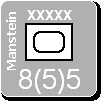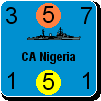wosung
Posts: 692
Joined: 7/18/2005
Status: offline

|
Some data and a short reflexion on factories and resources in China. But don't expect an easy answer. I prefer to lay out some facts for discussion how/if to implement.
Resources and factories in China proper (without Manchuria and Formosa):
As far I can see on the MWIF map there are 14 factories (4 of them red) and 11 Ressources
Factories:
1 Peking
1 Sian
1 Lanchow
1 Nanking
2 Shanghai (1 red)
1 Chengtu
2 Chungking (1 red)
1 Changsha
1 Kweiyang
1 Kunming (red)
2 Canton (1 red)
don’t know about Kashgar
Ressources:
1 (3 hexes E of Paotow)
1 (3 hexes NE of Chengchow)
1 Sian
1 (2 hexes NW of Lanchow)
1 (SW of Suchow)
1 Chengtu
2 Chungking
1 (SW of Changsha)
1 (2 hexes SW of Kweilin)
1 Kunming
Hope, I didn’t leave out something.
A few facts and figures about Chinese war economy:
In the 1930s Chinas share (without Formosa) of global output ammounted to:
0,5 % of iron ore (2 Mio to. per annum) The most important iron mines seemed to be Pinghsiang (1 hex SE of Changsha), the areas of Nanking, Wuhan and Taiyuan, the Mouth of Yellow river (Northern Route), and the coastal hex East of Peking
1,6% of coal (25,7 Mio to. p.a.) Most of Chinese coal is not in deep mines but in extensive shallow fields. The provinces with the highest number of big coal fields were: Shensi (11), Shantung and Liaoning (6 each), Anhui (3)
0,00008% of petroleum
Practically all iron and coaking coal for heavy industry purposes was imported.
(Source: Tang leang-Li, The Reconstruction of China, Shanghai 1935, pp. 50-52, Map 2.)
In the 1930’s and 1940’s Chinas’ most important raw material exports were
tungsten (37,7% of world production, used for machine tools, armour plates armour piercing shells)
antimony (22% of world production, used as lead hardener)
cotton (10% of world production)
(Source Oxford companion of WW2, pp 1063.)
In the 1930s The KMT regime under Chiang tried to prepare for the coming war with Japan. With German help (Seeckt, Falkenhausen, IG Farben, Junkers), it tried to transform itself into a technocratic development dictatorship. It started to plan and build up a huge ressource and defence bureaucracy and centralized heavy industry in the Hinterland (mainly Hunan, Kiangsi, less in Szechwan). The German advisors esp. pressed for a Chinese industry for small infantry weapons, in case all the exports would stop due to Japanese possession of coastal China.
(Source: Fu Pao-jen Military advisors and German assistance for Chinese Industrialization, in B. martin (ed) The german advisory group in China, Freiburg 1981.)
After the war started in 1937, 639 factories (110.000 tons) and some 43.000 skilled workers were moved to the hinterland, including 230 machine making plants and the equipment of the arsenals in Wuhan and Shanghai. Big problem was: Where’s the hinterland? Thus Free China established a improvised refugee industry, which makes the SU industry exodus look like a perfect planned and executed maneuver.
The Free Chinese hinterland was economical underdeveloped to say the least. Before the war only 4% of the industrial capital went to Szechwan. Till 1938 the regime lost 63% of its tax income but the expeditures rose 33%.
Free China held only 10% of the industrial output of China (including Manchuria). Its production peak was in 1943 (but only 12% of the prewar output of China proper).
In 1944, it produced 49.000 kilowatts (Occupied China: 642.000 kilowatts, Manchuria 600.000 kw).
In 1944 the Kansu Petroleum production and refining Administration was by far the most important oil producer in China. It produced 20 Mio. gallons crude Petroleum (7 Mio. gallons gas, diesel, kerosene) using innovative native technology. In 1943 642.000 gallons were refined from vegetable oil and from trees.
In 1943 Free China produced 10.000 to. of steel (10% of the prewar output).
The numbers for tungsten are 16.000 to (1937) and 9.000 to (1943).
(Source William C. Kirby, The Chinese War economy, in Hsiung/Levine: China’s Bitter Victory, London 1992.)
Bottom line:
It’s not so easy to model the refugee economy in wartime China, mainly for 3 reasons:
1. MWIF uses a static map with fixed ressources and factories.
2. Resources and factories are hex-bound. This fits good to the centralized economy of the industrialized world of WW2, but less good to the decentralized realities for “underdeveloped” China (dispersed industry, coal fields).
3. Under wartime circumstances, not few so called Maps about war time China tended to still represent the prewar situation (lots of heavy Industry in Shanghai and Canton).
Regards
|
 Printable Version
Printable Version





 Or else get use to running older programs under XP emulation(?)
Or else get use to running older programs under XP emulation(?)









 New Messages
New Messages No New Messages
No New Messages Hot Topic w/ New Messages
Hot Topic w/ New Messages Hot Topic w/o New Messages
Hot Topic w/o New Messages Locked w/ New Messages
Locked w/ New Messages Locked w/o New Messages
Locked w/o New Messages Post New Thread
Post New Thread